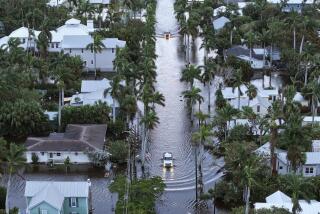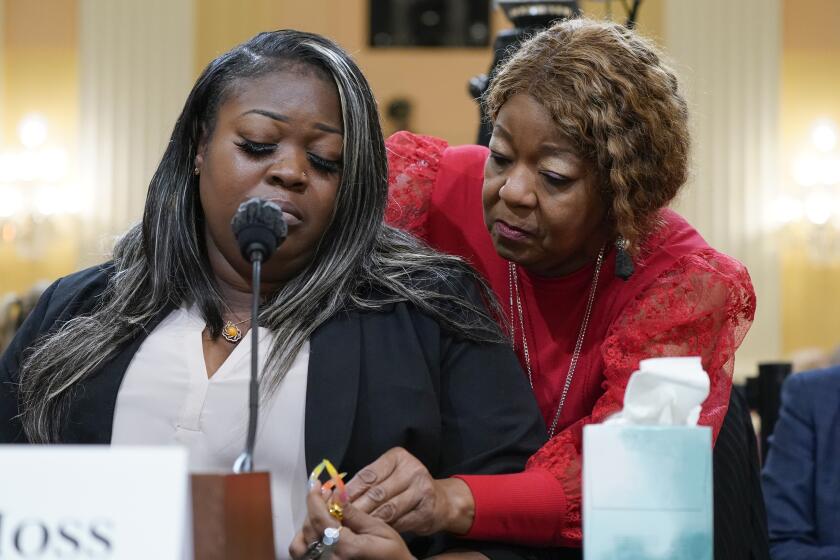At least 16 dead in storm-battered Florida after Hurricane Milton as rescue, recovery efforts continue

- At least 16 people died during the storm and its aftermath, with search and rescue efforts continuing.
- More flooding is expected as water levels continue to rise in a number of rivers.
- Tough decisions remain for residents on whether to rebuild in the face of increasingly powerful storms.
Hurricane-weary Floridians picked up a familiar routine Friday — assessing storm damage and clearing out muck and debris — a day after Hurricane Milton tore through the state, flooding low-lying barrier islands and inland communities in the heavily populated central west coast and spawning deadly tornadoes in the east.
At least 16 people were dead, killed by tornadoes, falling trees, downed power lines, wrecked vehicles or medical emergencies after Milton lashed the state with powerful wind and rain.
In just 24 hours, Milton dropped more than 18 inches of rain on St. Petersburg — a more than 1-in-1,000-year rainfall event for the area, according to the National Weather Service.
And the threat of flooding had still not receded.
In Dover and Lithia, small communities about 20 miles inland from Tampa, rescue teams plunged into murky brown water to save seniors and families trapped in flooded homes as the Alafia River swelled. In some homes, the Hillsborough County sheriff’s office said, the water rose as high as 6 feet.
“Where’s everybody at?” a rescue worker from the Hillsborough County Sheriff’s Office yelled Friday morning as he waded into a flooded home in Dover. The living room was bobbing with armchairs, sneakers and pillows. “How many people? 1, 2, 3 ...”
A family of eight, including a child, was inside.
“Hey, if you have any trouble, let somebody know,” the rescue worker told the residents as they clung on to a yellow rope affixed with buoys and began to be escorted outside to safety.
After making landfall as a Category 3 storm near Siesta Key, a barrier island in Sarasota County, Milton barreled east with powerful winds and tornadoes that downed trees, snapped power lines, flipped semitrucks and tossed houses off their foundations.
By Friday afternoon, long after Milton exited the peninsula, more than 1.3 million people were under a coastal flood warning, according to the weather service. The service forecast moderate to major river flooding in central Florida and the St. Johns River basin over the weekend and through the coming weeks.
Milton was the third hurricane to make landfall on Florida’s Gulf Coast this year. On Aug. 5, Debby, a Category 1 hurricane, made landfall near Steinhatchee, a lightly populated area of the Big Bend region. On Sept. 26, Helene, a more powerful Category 4 hurricane, brought catastrophic flooding and damaging winds to a large stretch of the Gulf Coast before barreling north into Georgia and North Carolina.
Climate scientists with World Weather Attribution, a group that studies extreme weather, said in a report Friday that extreme rainfall events such as Milton are “20-30% more intense and about twice as likely in today’s climate, [which] is 1.3°C warmer than it would have been without human-induced climate change.”
President Biden said Friday the damage from Milton, the third major storm to hit Florida in three months, was expected to cost nearly $50 billion.
“I want everyone in the impacted areas to know we’re going to do everything we can to help you pick back up the pieces and get back to where you were,” Biden said at a news briefing.
But as evidence builds that hurricanes are intensifying more rapidly and storm surges are becoming more destructive because of sea level rise, some question the wisdom of rebuilding on low-lying coastal land.
“We’re seeing more frequent rapid intensification, and we’re seeing more Category 4 and 5 storms, and a big part of that is just the fact that the Gulf of Mexico and the world’s oceans are heating up so much,” said Ben Kirtman, a professor of atmospheric sciences at the University of Miami’s Rosenstiel School of Marine, Atmospheric and Earth Science.
Kirtman said Floridians should rethink whether they rebuild on barrier islands.
“When you think about how we have to deal with the challenges of climate change here — not just more Category 4 or 5 storms, but also sea level rise and more storm surge — you do need to think about how you want to build,” Kirtman said. “I think Florida is a beautiful place. Should people continue to live and enjoy life here? Absolutely. But we need to be smart, so that we build resilient communities.”
Asked Friday whether Floridians should be prevented from rebuilding in low-lying areas, Florida Gov. Ron DeSantis said no.
“The reality is people work hard to be able to live in environments that are really, really nice, and they have a right to make those decisions with their property as they see fit,” DeSantis said at a news conference in St. Petersburg. “It is not the role of government to forbid them or to force them to dispose or utilize their property in a way that they do not think is best for them.”
DeSantis said it was tough for residents to face back-to-back storms but Floridians had a lot of resilience. After Hurricane Ian hit Florida in 2022, he said, a lot of people asked: “Are people going to want to live in southwest Florida?”
“Within two weeks, you had people buying up homes, people wanted to get down there.” DeSantis said. “So I think that there’s always going to be a demand to live in a beautiful part of the world.”
Many on Florida’s west coast were relieved that Milton weakened to a Category 3 hurricane before it made landfall and did not bring record storm surge that would have wiped out their homes. But they were left shaken by the familiar routine of evacuation and cleanup, loss of power and gas.
After surveying the impacts of Milton in Manatee County in a helicopter, U.S. Rep. Vern Buchanan (R-Fla.) said it was “truly devastating to see homes in such disrepair, knocked on their sides, roofs ripped off and sand and debris everywhere.”
“A lot of homes kind of almost rolled into the water,” Buchanan said. “I’ve never seen it before, I’ve lived on the water for 30 years.”
More than 2 million Florida customers remained without power Friday afternoon, according to Poweroutage.us, which tracks national power outages. Three out of 10 gas stations across Florida had no fuel.
In St. Petersburg’s low-lying Shore Acres neighborhood — a middle-class community populated by nurses and teachers — Garry Rosseter, the owner of a small window-cleaning business, said he was not ready to give up on his modest midcentury two-bedroom bungalow a few blocks from the water. He had lived there for almost a quarter of a century.
Milton crashed an oak tree into his spare bedroom window. But the damage was not as severe as last month, when water from Helene rose above the one-story home’s windowsill, or even as great as last year, when Hurricane Idalia flooded his home in 6 inches of water. Over the last week, he has sparred with his insurance company because the white cabinets lost in Helene were the same color as the ones he lost in Idalia. They asked whether he’d had them replaced at all.
Rosseter, 68, thought his home was worth saving — even if all the doors, drywall and lower kitchen cabinets needed to be replaced.
“You can’t sell it like this,” he said matter of factly as he cleaned a table in his carport to make a staging area for his repairs. “It’s just another renovation. I’m not going to make an emotional decision based on this hurricane season.”
For now, Rosseter is sleeping on his sister’s couch as he waits to hear whether the Federal Emergency Management Agency will give him a camper he can put in his driveway as he makes repairs.
The $750 provided by FEMA, he said, was enough to put gas in the car and keep him fed. But he could not hire contractors until insurance money or other assistance comes in.
On the northern end of Longboat Key, Lynn and Steve Roberts were in good spirits as they walked around their two disaster-stricken investment townhomes, stepping around broken glass from one of their neighbor’s back windows.
A few weeks ago, Helene flooded the units with 8 inches of storm surge. Milton didn’t bring more flooding, but it tore the roof off, leaving a piece dangling several dozen feet above in a nearby pine tree.
“It’s dry when it’s not raining,” Steve, a 65-year-old emergency room doctor, joked.
“Think we were due,” Lynn said, noting they had never filed an insurance claim in 25 years living in hurricane-prone South Carolina, the Florida Panhandle and now south Florida.
The couple purchased the two units in the last year to rent as Airbnbs.
Lynn, trying to stay busy and productive, pulled things from the upper cabinets to take back home, since those would have to be ripped out after losing the roof. An insurance adjuster would come out in three days, on her birthday. “It’s my birthday present,” she said, laughing.
The couple said it was a shame to lose so much of the property, but they weren’t giving up on it.
“We bought it ‘cause of this,” she said, pointing to the serene lagoon at the back of the property. “We love to be on the water, and it’s worth it to us to stay here. We’re not going anywhere.”
Both said they felt grateful to have another place to lay their heads at night, but knew others had felt the brunt of both storms. “For us, it’s an inconvenience,” she said. “For others, it was their livelihoods.”
There is still potential for additional storms before hurricane season is over at the end of November.
Matthew Rosencrans, the lead for the National Oceanic and Atmospheric Administration’s seasonal hurricane outlook, said it is too early to tell if those storms will make landfall and, if so, where the greatest effects will be.
“We are looking at relatively enhanced odds of tropical cyclone formations in the western Caribbean, south of Cuba,” Rosencrans said. “Storms there do tend to kind of move towards the Gulf of Mexico, although they can be swept directly from southwest to northeast.”
Times staff writer Hannah Fry contributed to this report.
More to Read
Sign up for Essential California
The most important California stories and recommendations in your inbox every morning.
You may occasionally receive promotional content from the Los Angeles Times.












